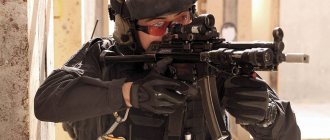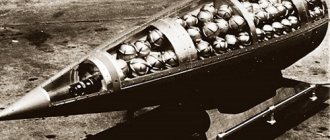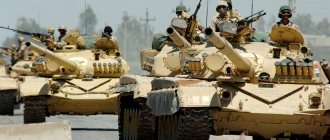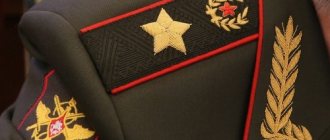Currently, there is a lot of talk about the fact that the NATO army is constantly increasing its forces and preparing for joint military operations with the United States against Russia. In order to understand what real force the NATO army represents, one should consider in detail the German army, as the strongest in this alliance.
To get a complete picture of the state of affairs in the German army as of 2022, it is necessary to consider in detail all types of troops that make up its composition.
German ground forces
As in any other army in the world, the main force of the German army is the Ground Forces. Their total number significantly exceeds the number of all other types of troops of the German army. As of 2022, the German Ground Forces consist of the following units:
- 4 NATO “rapid deployment” corps: “Eurocorps”, NATO AK BR, German-Dutch corps and German-Danish-Polish corps;
- 5 operational groups that are located in the Alliance army corps: French, Spanish, Italian Turkish and Greek corps;
- 5 divisions and a number of different units and units;
- Various tank divisions and brigades;
- Mountain infantry and motorized infantry brigades;
- Airborne brigades;
- Helicopter regiments, which include fire support helicopter regiments and light transport helicopter regiments.
At first glance, the size and composition of the German Ground Forces in 2022 is quite impressive. Moreover, numerous international exercises have proven that modern detachments in their combat power and capabilities are twice as large as the detachments of the 70-80s, which had the same number. It turns out that the 5 divisions that exist in 2022 can replace the 11 divisions of previous years. However, recent events in Iraq have shown the fallacy of these judgments. Firepower is, of course, good, but it is the infantry that must carry out operations to clear the territory. This is where its insufficient numbers come into play.
Despite the loud words that are spoken to the world media, the military command is well aware that the number of Ground Forces is insufficient. That is why even the official document on Germany’s military development directly states that the German army is intended for peacekeeping operations, as well as for localizing low-intensity conflicts. The main emphasis is on the fact that the German army will act as part of a coalition of forces.
Although in 2022 many Germans are still convinced that Russia should tremble at the mere sight of the sign of the German army, judging by the “successes” of the Ground Forces in Iraq, only one thing can be said: the Bundeswehr army can compete on equal terms only with third world countries, yes and then with quite small ones. German military doctrine does not provide for any global wars, and the latest terrorist attacks in Europe show that the NATO army is not able to restore order even in its homeland.
Civil society in Germany believes that although the army is an obligatory attribute of a solid state, it can be significantly reduced. Serious reductions in the German army began after the abolition of compulsory military service in 2011. Since then, the entire German army has been made up of contract soldiers. The prestige of military service in the Ground Forces can be evidenced by the fact that almost 10% of vacancies in the army are open. There is a major shortage of doctors and qualified personnel to maintain complex defense and weapons systems.
If 20 years ago the Germans were considered the best soldiers in Europe and even civilians were ready to happily serve in the army, now even professional German contract soldiers treat their service as an ordinary job. Although the contract details the duties of military personnel in the event of war, few take them seriously. If some major military conflict were to occur, all German Ground Forces would be completely at a loss, since the army has no real combat experience.
According to statistics, many German military personnel are on various operations in hot spots of the world, so either rear units or headquarters workers remained. Despite US pressure, Germany stubbornly avoids participating in operations that could turn into infantry battles. For example, the Bundeswehr does not want to openly oppose IS in Syria and Iraq.
Doctrines, participation in blocs
2017. The use of the Bundeswehr in operations abroad, part 1 Foreign Military Review. 2022, No. 5 P. 18-25
2017. The use of the Bundeswehr in operations abroad, part 2 Foreign Military Review. 2022, No. 6 P. 35-39
2018. Military doctrinal foundations of Germany’s new defense policy Foreign Military Review. 2022, No. 6 P. 19-25
2014. Military doctrine of Germany Foreign military review. 2014, No. 12, pp. 16-20
2012. Military doctrine of Germany Foreign military review 2012 No. 9 P.13-18
2011. Plans for reforming the armed forces of Germany: the Bundeswehr of the future Foreign Military Review. 2011. No. 9. pp. 11-19
2010. Concepts for network-centric combat control of the US, UK and NATO Armed Forces. General and differences Foreign military review. 2010, no. 4, pp. 7-18
1980. Development program of the Bundeswehr Foreign Military Review 1980 No. 2 P.14-16
2013. NATO Rapid Deployment Army Corps Army Collection. 2013. No. 11. pp. 41-44
2013. NATO Rapid Deployment Joint Army Corps Foreign Military Review 2013 No. 5 P.39-52
2020. National strategy for the protection of critical infrastructure in Germany Foreign military review. 2022, No. 5 P. 26-34
2020. Cybersecurity of German infrastructure Foreign Military Review. 2022, No. 9 P. 10-16
2020. Security of the German electrical power system Foreign military review. 2022, No. 12 P. 9-14
2014. Treaty on Open Skies Foreign Military Review. 2014. No. 3.
2006. Prague commitments of NATO countries and the progress of their implementation Foreign Military Review. 2006, No. 9, pp. 11-16
Armament and composition of the German Ground Forces
If we take official statistics, the armament of the Bundeswehr Ground Forces looks quite impressive:
- The total number of tanks is 1095 units;
- Various field guns and MLRS – 644;
- 2,563 armored vehicles;
- 146 combat helicopters.
The picture is quite encouraging, but this is only at first glance. In fact, in reality everything is somewhat different. If you look at the situation with German tanks, you can see that the main German tank is the Leopard of various modifications.
Of the total number of “paper” tanks, tanks of the “Leopard-2” modifications account for 685 units. The remaining tanks are Leopard-1, which are mostly dismantled for metal or used as targets at training grounds. Although the development program includes the purchase of the latest modification of Leopards, in reality the fleet renewal is proceeding very slowly. The military budget is becoming smaller and smaller from year to year. There are no more than 100 of the newest Leopards in the German army. If you look at the total number of tanks that are quite modern today, you will get no more than 500 units, and half of them will be quite outdated modifications of the A5.
Looking at the real numbers, it becomes clear that the hopes of the NATO member countries to protect the German armada of tanks in the event of a global war are, to put it mildly, exaggerated.
Light armored vehicles of the German army
The Bundeswehr's approach to modernizing light armored vehicles is interesting. Although local operations require just such equipment, because sending tanks on missions to eliminate small outbreaks is unprofitable, and the maneuverability of tanks is limited. The modern fleet of light armored vehicles in Germany is represented by the obsolete Marder infantry fighting vehicles, which began to enter service with the German army back in 1961, although even then this process lasted almost 10 years. The first modernization of the Marders began only in September 1979. The upgraded models received the index "A-1" and received an additional Milan anti-tank missile launcher, which was installed on the turret on the right side.
In 1985, when the “Marders” were presented in three modifications (from “A-1” to “A-3”), development of a new modification “Marder-2” began. With the start of development of Marder-2, the production of previous modifications was completely curtailed. Since during these years military funding began to gradually decline, the development of the new Marder lasted for 6 years.
The first Marder-2 vehicle was shown on September 17, 1991. Its testing continued until 1998, and as a result of the fact that its production turned out to be too expensive, it was completely abandoned, practically “burying” many years of work. Until now, Marder-1 is the main infantry fighting vehicle of the German army. Due to the fact that even its latest modifications were released more than 30 years ago, their number is decreasing from year to year, as they are gradually dismantled for spare parts. As a result of this, out of 1581 Marders that are in service, no more than 350 units remain on the move.
Since the need to adopt a new infantry fighting vehicle has been around for a long time, a new vehicle was developed and put into service - the Puma infantry fighting vehicle. In 2016, the Bundeswehr was supposed to purchase about 400 new vehicles, but in fact, not a single such infantry fighting vehicle was purchased.
It turns out that in terms of ensuring infantry mobility and fire cover, the Bundeswehr army is provided only with wheeled armored personnel carriers and vehicles:
- 430 TpZ-1 “Fuchs”;
- 359 “Wiesel”;
- 51 "Boxer".
Although about 1,500 pieces of American obsolete M-113 infantry fighting vehicles should be stored in the Bundeswehr army warehouses, nothing has been reported about them since 1995. Most likely, they have long been dismantled for scrap.
In total, 1,130 armored personnel carriers remain, although more than 300 of them are “Viesels”, which are absolutely not intended for transporting infantry. The remaining quantity is about 800 pieces. In order to understand whether this is a lot or a little, we will show some interesting statistics. Ukraine lost approximately 800 armored personnel carriers of various modifications in 2014, so there is no need to fear that the German army has a powerful base of light armored vehicles. The army, which has not participated in military conflicts for more than 60 years, is severely out of touch with reality.
Notes
- Anordnung des Bundespräsidenten über die Kennzeichnung der Luftfahrzeuge und Kampffahrzeuge der Bundeswehr (German). Bundesanzeiger Verlag GmbH
. Date accessed: June 3, 2022. - Bundeswehr wächst um 3.000 Soldaten in einem Jahr (German) (inaccessible link). Bundesministerium der Verteidigung (27.08.2019). Retrieved August 29, 2022. Archived August 29, 2022.
- Parkhitko N.P. The evolution of German military policy after unification (inaccessible link) Bulletin of MGIMO (U), No. 5(14), 2010
- Glazunov N.
West German military historiography on the role of the Bundeswehr in the NATO system. // Military historical magazine. - 1973. - No. 11. - P. 99-105. - Soviet military encyclopedia: 8 volumes / Chairman. Ch. ed. commission N.V. Ogarkov. - M.: Military Publishing House of the USSR Ministry of Defense, 1976-1980. // T. 8: “Tashkent” - Rifle cell. - 1980. - P. 261.
- Military encyclopedia in 8 volumes. T. 2: Babylonia - Guys / Ch. ed. commission P. S. Grachev. - M.: Voenizdat, 1994. - P. 394.
- Compulsory military service Archived October 24, 2013 on the Wayback Machine
- Ionova E.P. Geopolitical aspects of the presidential elections in Uzbekistan // Russia and the new states of Eurasia. — 2015. — No. 2 (27). — P. 105
- Wie lauten die Einsatzzahlen? Aktuelle Personalzahlen der Bundeswehr [Current strength of military personnel and personnel of the Bundeswehr abroad] (unspecified)
. Date of access: 13. December 2022. - Press conference of His Excellency Franz-Josef Overbeck; Press conference - Bischof Dr. Franz-Josef Overbeck
- Appointment of the head of the military ordinariate for Germany; NOMINA DELL'ORDINARIO MILITARE PER LA REPUBBLICA FEDERALE DI GERMANIA Archived copy of February 23, 2012 on the Wayback Machine
- Regimental imams will appear in the German army
German artillery at present
German artillery also came under massive reduction. About 650 guns, mortars and MLRS were removed from service. To replace outdated technology, Germany began to develop the latest weapons systems. Taking their cue from the Americans, the Germans developed systems that made it possible to significantly increase firepower, even with large-scale reductions.
German designers have developed the PzH2000 self-propelled gun, which is considered one of the best combat vehicles in its class. The PzH2000 self-propelled artillery mount has the following tactical and technical characteristics:
- This gun provides targeted coverage of a target at a distance of 30 kilometers, while it fires 3 shots in 9.2 seconds;
- 8 shots fired in 51.4 seconds;
- 20 shots - in 2 minutes and 30 seconds.
As a result of constant improvements and upgrades, German designers were able to increase the rate of fire of this gun to 59.74 seconds - 12 shots and 1 minute 47 seconds - 20 shots.
This self-propelled artillery unit is capable of reliably protecting its crew from small arms fire with a caliber of up to 14.5 mm and any artillery and mortar fragments. There is reactive armor that covers the top of the installation, protecting the crew from aircraft bombs and artillery shells.
Of course, the PzH2000 self-propelled gun is one of the best systems of this type in the world. It is for this reason that it completely replaced all systems of similar types from the German army. It seems that everything is fine in the artillery of the German army, if not for one problem: their total number does not exceed 180 units.
In addition to the PzH2000 self-propelled guns, the German Ground Forces have no more than 130 self-propelled mortars of 120 and 100 mm caliber. Military experts will definitely pay attention to the fact that the Bundeswehr army has a very small number of mortars with a caliber of less than 120 mm. These tasks must be solved by army aviation, since the military command believes that batteries of such weapons are not capable of quickly changing their location and will not bring any benefit in a real battle, so NATO’s main bet in such matters is combat attack helicopters.
Clergy in the Bundeswehr
Religious education in the German armed forces has always been given serious attention. Although there was no legislation on military clergy until 1919, already at the end of the 15th century the German Landsknecht regiment had a regimental chaplain on its staff.
In 1919, a military-spiritual administration was created, which was part of the judicial branch of the pension and judicial department. At the head of the administration were the field chief evangelical and field chief Catholic priests. In Prussia, the military clergy of the Evangelical Church was under the supervision of the military chief pastor (Militär-Oberpfarrer). In the branches of the military, the military clergy reported to the senior pastor. The religious needs of Lutherans and Catholics were met separately.
The residence of the senior pastor of the German Navy was in the city of Kiel. Each priest of the German navy had up to 4 ships under his jurisdiction, on which he alternately performed divine services on Sundays. In addition, the pastor came to the ship twice a week to talk with the crew. For conversations, which were usually of a religious and military-historical nature, official time was allocated. During the conversation, the entire ship's crew was relieved of work.
With the entry into force of the Weimar Constitution of 1919, the state and church in Germany became independent of each other. But the basic law of the republic enshrined the right of military personnel to satisfy religious needs.
After World War II, a new relationship developed between the church and the Bundeswehr, which differed from the patterns of activity of the military clergy in other Western countries. Article 4 of the German Constitution states: “Freedom of faith, conscience and freedom of religious and ideological expression are inviolable. The unhindered execution of the dictates of religion is guaranteed.” The same thing is discussed in Article 36 of the law on military personnel, adopted in 1956: “A military serviceman has the right to receive spiritual guidance and the unhindered performance of religious duties. Military personnel take part in religious services on a voluntary basis.” In August 1956, the Minister of Defense signed the Bundeswehr directive ZDV 66/1 on the organization of military-church service in the troops. The directive defines the organization of spiritual education in the armed forces and sets the corresponding tasks for clergy and unit commanders, and shows the forms of activity of military priests. The directive provides for the participation of priests in the work of councils on issues of “internal leadership” under unit commanders and obliges them to conduct worship services, perform religious rituals, organize leisure time for military personnel, classes on moral issues, group and individual conversations with military personnel. In July 1957, the law “On Spiritual Services for the Army” was adopted, according to which the activities of the military-church service are financed mainly from the state budget. The general direction of this service is entrusted to the Evangelical and Catholic military bishops.
The Military Ordinariate of Germany (English: The Military Ordinariate of Germany, German: Katholische Militärseelsorge) is a territorial unit in the Roman Catholic Church, equivalent to a diocese, created for pastoral care of Catholic military personnel. Since 24 February 2011[10], the German Military Ordinariate has been headed by His Excellency Franz-Josef Overbeck, who is also Bishop of Essen (since 28 October 2009[11]).
Also in the Bundeswehr are priests of the Protestant (Evangelical) Church. The Lutheran Military Bishop is appointed by the Council of the Evangelical Church of Germany in agreement with the federal government. The total number of Catholic and Protestant chaplains serving in the Bundeswehr is about 90[12].
Army aviation and air defense of the Bundeswehr
As for the Bundeswehr army aviation, it includes the following types of helicopters:
- 38 powerful Tiger attack helicopters. Although the Bundeswehr's immediate plans included the purchase of another 20 units of such equipment, budget cuts are unlikely to contribute to their implementation;
- 118 VO-105 light attack helicopters, which can also be used as multi-purpose helicopters. Another 24 helicopters of this model are in storage, but it is unknown what condition they are in. Given the Army's old habit of dismantling Army equipment, it is unlikely that they are in combat condition;
- 93 CH-53G transport helicopters;
- 93 multi-role UH-1D and 39 EC-135 units;
- The most modern helicopters are 77 NH-90 units.
If all these helicopters are in combat condition, then the position of the Bundeswehr army aviation is quite stable.
The army's air defense system is represented by 50 units of Ocelot air defense systems, which are in fact nothing more than 4 Stinger MANPADS launchers, which are installed on the chassis of the Wiesel combat vehicle. There is no need to say that the Stingers are quite outdated weapons in modern realities, although during battles with a technically backward enemy they pose a significant threat to targets located at low altitudes.
German Air Force
The Luftwaffe includes Central Command and Operational Command. Since Germany does not have its own training bases for training cadets, all German Air Force pilots are trained in the United States of America.
The basis of the German air force are the following aircraft:
- The most important force of the German Air Force is the Typhoon fighter-bombers. When their production was first planned, the Air Force planned to purchase only 250 aircraft, but in the end, today there are only 97 of them, if you count them together with training aircraft. The global reduction in the army also affected the German air force, so the air force command had to somewhat moderate its appetites;
- Second in importance, but first in total number are the Tornado bombers, which have been modernized. Their total number is 144 units. The modernization was carried out in order to make it possible to leave the Tornado in service with the German Air Force until 2025. In future plans they want to completely replace them with Typhoons. However, since the Typhoons are in short supply even in their “fighter” category, we can hardly expect a replacement for the Tornado by 2025;
- Due to the acute shortage of combat aircraft, the German Air Force is still in service with the F-4F Phantom 2, which began production back in 1961. These aircraft are also planned to be replaced by Typhoons by 2022.
Based on the data presented, the strike aviation of the German Air Force should be about 200 aircraft by 2029. For comparison, we can say that Russia has about 3,500 aircraft in service that can be used for military purposes. therefore, German military aviation does not pose any significant threat to Russia.
The transport aviation of the German Air Force does not exceed 100 aircraft, which are not even able to ensure the landing of an entire brigade of paratroopers, and you can immediately forget about supplying it with ammunition and provisions.
The air defense of the German Air Force includes no more than 18 batteries of the Patriot air defense system.
Structure of the German Armed Forces
2019. Central health service of the Bundeswehr Foreign military review. - 2022. - No. 4. — P. 35-42
2014. Medical and sanitary support in the Armed Forces of the Federal Republic of Germany Foreign Military Review. 2014. No. 3. P.22-28
2018 German Ministry of Defense: functions and structure Foreign Military Review. 2022, No. 2 P. 22-30
2020. Strategic Intelligence Command of the German Armed Forces Foreign Military Review. - 2022. - No. 11. — pp. 21-25
2019. The main tasks of German intelligence in modern conditions. Foreign Military Review. - 2022. - No. 11. — P. 20-23
2019. Cyber operations and information support forces of the German armed forces Foreign military review. - 2022. - No. 9. — pp. 21-25
2017. Cyber operations and information support forces of the Bundeswehr Foreign military review. 2022, No. 7 P. 23-25
2013. Special Operations Forces of the Armed Forces of the Federal Republic of Germany Foreign Military Review. 2013. No. 9. pp. 15-20
2012. Silts of special operations of the Bundeswehr Foreign Military Review 2012 No. 3 P.30-39
2003. Bundeswehr special forces Foreign military review 2003 No. 9, pp. 33-36
2010. Interspecific component of the Armed Forces of Germany - Joint Support Forces Foreign Military Review. 2010, no. 2, pp. 15-24
2009. Strategic Intelligence Command of the Joint Support Forces of the German Armed Forces Foreign Military Review. 2009, no. 9, pp. 24-31
German Army Navy
The German Navy, even in the face of military budget cuts, is sufficiently equipped and modern. At the same time, it is not able to solve any serious combat missions, since it is quite budget-friendly. Its tasks include solving local problems, such as coastal protection or intelligence activities.
It should be noted that military shipbuilding in Germany is one of the most modern in the world, and warships and submarines are bought up by various countries with great pleasure. Despite the high prices of submarines (about $330 million for a Type 212 in the “base”), they are in stable demand and bring constant income to the German economy.
Judging by the new German warships that are being built, they are clearly planning to place some new and powerful weapons on them.
The naval aviation of the German Navy also does not represent a significant force and is represented by the following types of equipment:
- 8 R-3C Orion aircraft, which are designed to combat submarines;
- 3 patrol Do-228;
- 43 helicopters of the Sea King and Super Lynx models.
Judging by the state of military shipbuilding in Germany, in the event of a large-scale military conflict, Germany will be able to acquire a powerful military fleet in a short time.
Military budget
2021. Composition and structure of German military expenditures Foreign Military Review 2022 No. 2 P.25-29
2011. Planning of military expenditures in Germany Foreign Military Review 2011 No. 4 P.21-23
2011. Military expenditures of the main NATO countries. Foreign Military Review. 2011. No. 8. — P. 20-25
1980. Expenses for the purchase of weapons for the Bundeswehr Foreign Military Review 1980 No. 2 P.20











